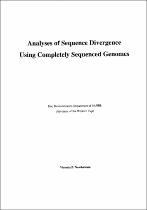| dc.description.abstract | Using the complete genome, Saccharomyces cerevisiae, which duplicated after its
speciation fuom Kluyveromyces lactics, a dataset of 119 putative S. cerevisiae - K.
lactis ortholog-pairs was constructed. S. cerevisiae paralogous pairs that are likely to
have duplicated during the whole genome duplication of S. cerevisiae were obtained
and the approach taken in our previous work (Nembaware et al., 20OZ), was repeated
to test whether the presence of a paralogue in S. cerevisiae had an effect on the rate
of sequence divergence of the 119 pairs of orthologous genes. We found, however,
that substitutions at synonymous sites had reached saturation and this prevented us
from being able to repeat the previous finding with S. cerevistae and K. lactis . From
this study a publicly available web-server (http://hamlyn.sanbi.ac.zal-victoria) that
automates the calculation of Ka:Ks values given a pairs homologous CDS sequences
is presented. | en_US |

